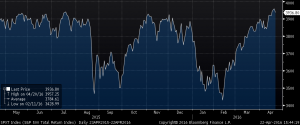Last Tuesday, the S&P 500 Index closed above 2100 for the first time since December; it is also currently trading within about 2% of last May’s all-time record close of 2130.82. In fact, the S&P 500 Total Return Index, which includes dividends, reached a new all-time high on April 19.
When the market was tumbling earlier this year many investors were concerned, and there was considerable speculation that we were about to enter a bear market. While it seems contrary to what would be expected, over the long term, the most money is made when the market is falling and not when it is rising. In a rising market it is much easier to pick stocks that increase in value. You might not pick the ones whose price increases the most, but you can still make money. On the other hand, when the market is falling, individual decisions can have a greater impact. A falling market can lead you to sell stocks in order to raise some cash and preserve capital. You may also choose to exit those holdings which you believe would tend to fare worst in a falling market. Alternatively, you may choose to buy stocks that have fallen well more than you think they should have because they are moving in sympathy with the market or with peers. Such stocks often rebound much more than the market, once the outlook brightens.
When the market falls, we often think the worst. In his 2007 book “The Black Swan: The Impact of the Highly Improbable,” finance professor Nassim Nicholas Taleb tried to educate the public about the danger of rare, unusual events. Such events are clearly important to investors. While the market crashes infrequently, crashes can have a significant negative impact on investors’ wealth as well as the economy. But, it is highly unlikely that we can predict the potential for rare events simply by looking at the past. If we know that in an average year there are 286 sunny days in Tucson, Arizona, our best guess is that there will be 286 sunny days there this year. If we make a forecast that is too far from the norm, it is unlikely that we will be correct.
The same applies with longshots in sports. If you went to Las Vegas before baseball season started this year, you could have gotten 150:1 odds on the Philadelphia Phillies winning this year’s World Series. Placing a $1,000 bet on that outcome could win you $150,000. However, the most likely result is that you would lose $1,000.
The same applies with markets. We can try to predict when the next crash will come, but if we are wrong, it will likely cost us money. Selling stocks to avoid a crash that never arrives will cost us in terms of lost gains, transaction costs and taxes.
A lot of time and energy can be spent trying to guess the unknowable. Over the long term, making emotional decisions about which securities to buy and sell based on the latest thing we read or a “gut” feeling is likely to result in our being wrong. Instead, it is better to have a rhyme and reason for our decisions – an established process that is regularly followed. While our decisions are not always going to be right, if we follow a process and maintain an investment thesis that allows us to assess the quality of our decisions, we are more likely to make good decisions. Over time, if we are willing to examine our decisions and understand where and why we were right or wrong, our decision making should also improve.



